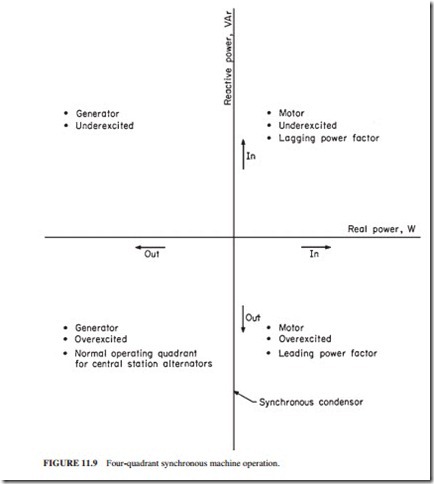MACHINE LOSSES
Synchronous machine losses include the following:
Windage and Friction Loss
The friction that the gas in the air gap exerts on the rotor causes a mechanical loss known as windage loss. Since the efficiency of a generator has a significant impact on the cost of power generated, most units having a rating in excess of 20 MW are hydrogen-cooled to improve the efficiency. The following are the advantages of hydrogen:
● The density of hydrogen is 14 times lower than that of air. Thus, the windage losses of hydrogen-cooled generators are significantly lower than those of air-cooled ones.
● The heat-transfer properties of hydrogen are significantly better than those of air. This allows hydrogen-cooled generators to operate cooler than the ones cooled by air. Thus, hydrogen- cooled generators have many fewer problems than those cooled by air.
● Hydrogen is an inert gas. It does not support corrosion whereas air enhances the corro- sion rate.
● Hydrogen extinguishes arc-initiated fires while oxygen is required to start them.
However, a large hydrogen leak from the generator can cause a fire or an explosion. The reason is that a mixture of hydrogen and oxygen containing hydrogen in a volu- metric concentration of 4 to 76 percent can become explosive. Despite this hazard, most
hydrogen-cooled generators have operated safely. Only a few rare incidents have been reported. The hydrogen is normally maintained at 45 to 60 psi (300 to 400 kPa) inside the generator. It is purged using CO2 to avoid explosion hazard.
Friction losses occur in the bearings and slip rings.
Core Losses
The core losses are the sum of hysteresis and eddy current losses. They can be reduced by decreasing the thickness of the laminations and using low-loss magnetic materials such as iron-nickel alloys, oriented silicon steel, or amorphous magnetic materials.
Stray-Load Loss
The stray-load loss is given by the increase in core losses with the current. It is caused by the induced losses from the leakage fluxes of the armature and variations of the flux distribution in the air gap. This loss includes the eddy current losses that occur in large armature conductors. This component of the stray-load loss is minimized by laminating the armature conductors using bundled conductors, strip conductors, etc. A typical value of this loss is around 1 percent of the power output.
Armature Conductor Loss
The armature conductor loss is defined as the sum of ohmic (or dc) loss and the effective (or ac) loss in the armature conductors. The effective loss is caused by the nonuniform flux distribution over the cross section of the conductor. This is known as the skin effect. It depends on the cross section of the conductor and the frequency of the armature current. The skin effect can increase the armature copper loss significantly if the conductor is large. The armature conductors are normally laminated or segmented to reduce this loss.
Excitation Loss
The excitation loss includes the loss of the field conductor and the automatic voltage regulator which controls the voltage at the terminals of the machine. The heat losses from the field conductor are normally included in the armature heat losses.
Related posts:
Incoming search terms:
- losses in synchronous machines
- losses of synchronous machine
- baseline hydrogen cooled generator windage loss calculation
- synchronous generator losses
- synchromous machine losses
- strag losses in synchrnous machibe
- power and losses in synchronous machines calculations
- machanical losses in synchrinous generator
- losses of synchronouus machine ppt
- Losses in synchronous generators
- loses in synchronous machine
- core losses in synchronous generator
- type of losses in synchronous machine
